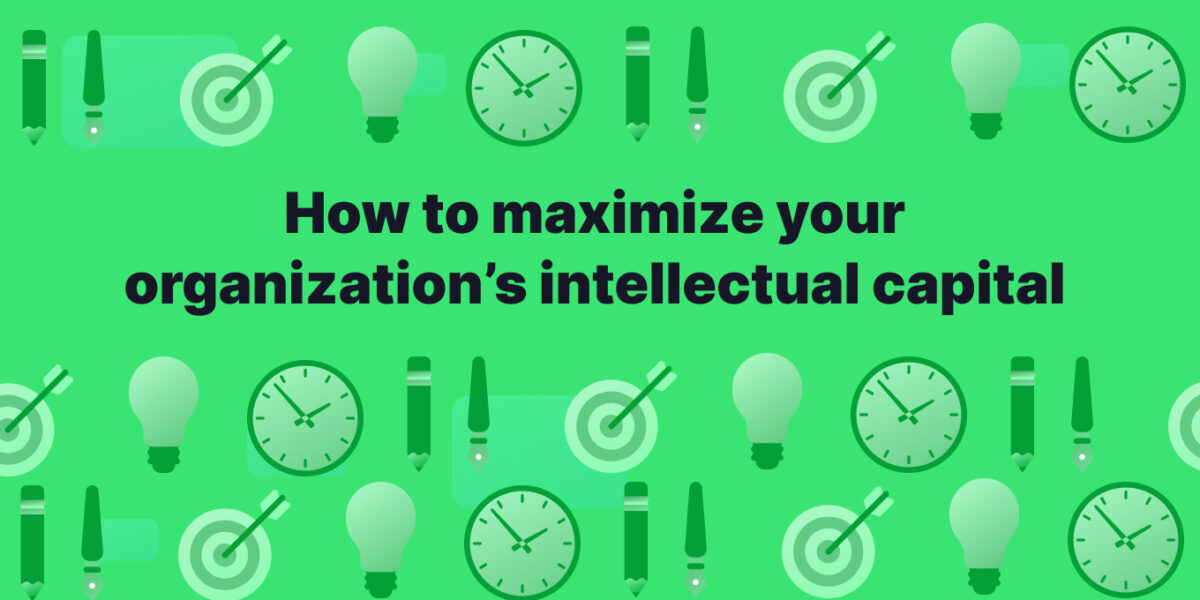Intellectual capital is an often over-complicated term, primarily due to its usage in academia. And you probably agree that academics are generally really smart, and sometimes be… verbose.
That being said, in his book ‘Intellectual Capital: The new wealth of organization,’ Thomas Stewart offers the succinct definition of intellectual capital as “packaged useful knowledge.” Comparing intellectual capital with other types of capital that we’re exposed to on a business level can help explain it further.
In this case, let’s consider financial capital. This is all the money your company has access to as well as the valuation of everything it currently owns. Now, apply the same logic to intellectual capital, but replace money with knowledge and all the information that’s in your team’s heads.
Intellectual capital is the total of a company’s knowledge. That includes knowledge held by employees and the relationships within the organization and with clients/partners. However, unlike money, knowledge is difficult to calculate accurately.
For example, a company will be able to calculate exactly how much it has paid out in salaries each year. It’s a simple process of totaling the amount paid to each employee during a specific time period.
However, how do you calculate how much knowledge an employee has transferred to a colleague or received from their training program? Do you ask them to tell you? That seems subjective. Do you test their “knowledge” and quiz on them on relevant topics? That seems like a waste of time. How do you even quantify that kind of information?
What is intellectual capital made up of?
Before attempting to measure intellectual capital, and ultimately use it to your organization’s advantage, it helps to understand what it comprises it. In their book, ‘Intellectual Capital: Realizing Your Company’s True Value by Finding Its Hidden Brainpower’, Edvinsson and Malone identify that intellectual capital consists of three key components:
- Human capital: Resources and knowledge possessed by groups of people
- Structural capital: Everything that supports human capital, e.g., hardware, buildings, etc
- Relational capital: Strength and loyalty of relationships within the organization, and with customers
How important is intellectual capital?
Research suggests that the wealth and value of organizations are increasingly based on intellectual capital, and it can have a direct impact on the financial performance of a company. For many companies that will be evidence enough for them to consider the importance of intellectual capital for their business. However, what’s one company considers important, might not be important to another when talking about intellectual capital. It’s not a one-size fits all process.
At car companies like Ford, Honda, and Tesla, the know-how and process behind the creation engines is essential. However, that same knowledge is of no value whatsoever to a financial services firm like Blackrock, or KPMG.
It’s an interesting point to consider because that same knowledge can heavily influence the growth and performance of Honda, yet have absolutely no benefit on KPMG – so is it fair to compare companies in different industries in terms of intellectual capital? Potentially not. But comparing the intellectual capital resources of two similar companies like Ford vs. Tesla is easier. It’s safe to assume the company with more intellectual capital documented is going to have a long-term competitive advantage of a company that is basically forgetting what it learns and reinventing the wheel constantly.
Another point to consider when discussing the importance of intellectual capital is the way in which intellectual capital is shared within your organization and how it flows from department to department.
For example, Amazon’s brand awareness and reputation are critically important. Their legacy of amazing customer service sets them apart from their competitors. However, without its efficient distribution network, robust internal processes, and strong supplier relationships, it would be tough for departments to exchange information about customers from between each other seamlessly. Without the ability to have information permeate the entire organization, blockages would build up, Amazon would lose its edge. Eventually, it would rapidly fade, and cease to exist because it got replaced by a nimbler organization that’s better at sharing learnings, just like exactly what Amazon did to Barnes & Noble and so many other bookstores over the last decade. In today’s modern economy, the organizations that learn the fastest win.
How to maximize your organization’s intellectual capital
Create and support connectivity and collaboration
Firstly, setting up the infrastructure so that employees can share knowledge is crucial. Management is tasked with the job of bringing together the experienced employees so that they can set their sights towards creating improvements and innovation. Some things to keep in mind when doing this:
- Outline why you’re bringing employees from different departments together
- Let your employees know that you’re striving for a more transparent and sharing environment to maximize the value of the firm’s intellectual capital
- Have a clear process in place – who is taking the lead? What tools or software is required?
- Have the measures in place to track the progress of the collaboration effectively e.g. will you be recording meetings, de-briefs, or asking employees to make notes?
Introduce some form of knowledge management
You want to establish a process that ensures all levels of employees have the opportunity to share and receive knowledge. Knowledge management exists to ensure those experienced employees can transfer their knowledge to the wider company before they leave.
Similarly, when new employees join they then have then the chance to absorb knowledge. This is typically achieved through activities such as:
- Employee orientation
- A mentorship program for graduates or trainees
- Efficient mapping of roles and responsibilities
There remains the issue of knowledge being lost during sporadic conversations. A knock-on effect of that is a decrease in the intellectual capital of an organization over time. In this case, you might find a knowledge management platform helpful – it allows teams to manage and share organizational knowledge.

